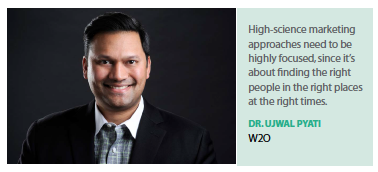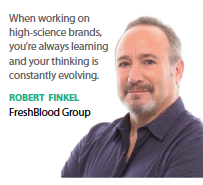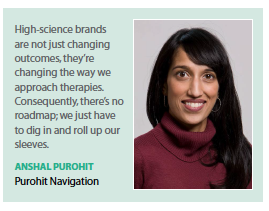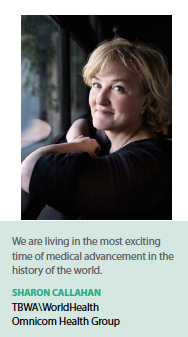The Challenge: Creating compelling campaigns for complex science
Cancer immunotherapies and other high-science brands will be busting the market at $34 billion by 2024, according to GlobalData. As the science around these types of treatments continue to drastically change therapeutic options, their commercial  success will depend on the speed with which they enter the market, their clinical and commercial positioning, target patient populations, and their marketing power.
success will depend on the speed with which they enter the market, their clinical and commercial positioning, target patient populations, and their marketing power.
High science is complicated, and marketing high-science brands, such as Merck’s Keytruda and Bristol-Myers Squibb’s Opdivo, requires certain skills beyond a traditional blockbuster or me-too brand marketing. At the same time, if you were to ask healthcare marketers if they would shy away from a high-science campaign if they had the chance, you would hear a resounding “No!" The excitement of working on breakthrough treatments and the impact those brands will have on patients make the task compelling.
“We are living in the most exciting time of medical advancement in the history of the world," says Sharon Callahan, CEO of TBWA\WorldHealth and chief client officer at Omnicom Health Group. “Pioneering science is being translated into breakthrough treatments for patients so quickly that it’s hard to keep up. From gene editing, to cell-based therapies, to immuno-oncology — the practice of medicine is transforming before our eyes."
“Given the choice, I prefer to work on high-science brands; I am drawn to the plight of patients and family members who struggle with more complex and/or  rare diseases," says Robert Finkel, CEO and founder of FreshBlood Group. “Quite simply, there is a level of seriousness and a greater sense of urgency that I attribute to diseases and treatments that generally fall into the high-science arena."
rare diseases," says Robert Finkel, CEO and founder of FreshBlood Group. “Quite simply, there is a level of seriousness and a greater sense of urgency that I attribute to diseases and treatments that generally fall into the high-science arena."
Take immunotherapy as an example; there are several promising and emerging new treatments with complex mechanism of actions that attempt to break immune tolerance and improve overall survival.
“I find the science fascinating and, professionally speaking, it’s more challenging to wrap your head around high science," Mr. Finkel adds. “When you’re working on high-science brands, you’re always learning and your thinking is constantly evolving."
Ujwal Pyati, Ph.D., practice lead of scientific strategy at W2O, and a scientist with a passion for oncology and other complex therapeutic categories, finds high-science areas to be the most intellectually stimulating. “These medicines often serve to fill a huge therapeutic need that has been addressed either insufficiently or not at all," he says.
In the case of rare diseases, Dr. Pyati says, there is an understanding of the genetic basis of the condition, but there are few tools to address the underlying genetic cause or its consequences.
“In the new era of translational gene therapy, gene editing, RNAi, and other amazing technologies, we’re taking what were once lab-restricted fantasies restricted to worms, flies, and other model systems, and finally applying them in  areas where standard drug development has fallen short," he says. “Furthermore, these advances are moving beyond small populations and into larger, more prevalent conditions such as hyperlipidemia, which is absolutely amazing."
areas where standard drug development has fallen short," he says. “Furthermore, these advances are moving beyond small populations and into larger, more prevalent conditions such as hyperlipidemia, which is absolutely amazing."
Purohit Navigation also focuses on the rare disease category and brings a strong understanding of patients into its high-science branding.
Engaging with patients on a formal and informal basis, followed by segmenting the patient population according to needs or different diagnostic/therapeutic pathways helps position the brand beyond a market and scientific context.
“We try really hard for our internal team to bring context to the brand right away," says Anshal Purohit, president of Purohit Navigation. “Whether we’re developing strategy, creative, or both, we constantly consider the patients’ perspectives and needs. We talk about what patients are experiencing currently, what the therapy is going to do for them differently, and what impact we expect our work to have on the market — meaning if we address the medicine successfully we can change what the market will look like in the future."
Ms. Purohit says patient inclusion not only inspires the teams working on the campaigns — right down to junior copywriters — but it also keeps the patient connection front and center throughout the entire creative process. Purohit Navigation uses patient advisory boards, market research, and patient panels to keep both clients and internal teams connected with patients.
Challenges with Complex Science Treatments
With high science, it takes considerably more effort to deliver relevant, often nuanced messages that credibly position the complex science behind new as well as established treatments.
One of the challenges is that messages need to get to the point quickly and deliver a concise, meaningful story about the science that one can quickly grasp and appreciate. In other words, marketers have to make the complex compelling, as author David Chapin says in his similarly titled marketing book — Making the Complex Compelling: Creating High-Performance Marketing in the Life Sciences.
The book provides guidance on how to create high performance marketing that is focused specifically on the nature and needs of the life-sciences marketplace.
“No matter which audience you’re communicating the science to — opinion leaders, prescribing physicians, patients, or caregivers — there is a need to get to  the point quickly and deliver a concise, meaningful story," Mr. Finkel says. “While it’s essential to differentiate one complex treatment from another, and leverage the science behind it, it’s also easy to get entangled in the granularity of the science, and particularly, the mechanism of action story. Generally speaking, a differentiated or compelling MOA can provide a strong reason to believe. Yet in the end, clinical evidence and personal experience is really what supports the decision to prescribe."
the point quickly and deliver a concise, meaningful story," Mr. Finkel says. “While it’s essential to differentiate one complex treatment from another, and leverage the science behind it, it’s also easy to get entangled in the granularity of the science, and particularly, the mechanism of action story. Generally speaking, a differentiated or compelling MOA can provide a strong reason to believe. Yet in the end, clinical evidence and personal experience is really what supports the decision to prescribe."
Dr. Pyati agrees that high-science marketing approaches need to be much more targeted, thoughtful, and cautious than say marketing blockbuster brands.
“In this space, we are often dealing with smaller patient populations that are challenging to reach and connect with, as well as HCPs who have little time to deeply understand the science in terms of a product’s key differentiators or even how to provide a proper diagnosis," Dr. Pyati says. “We need to be able to simplify the story while being very strategic about emphasizing the key differentiating features of the therapy."
Overall, having a deep understanding of who the audience is, how these patients think and behave, and where to generate impact is critical.
Dr. Pyati suggests not “going big" with huge digital ideas, since budgets may be smaller, and these ideas may actually set the wrong tone with audiences.
Another big challenge is educating the target audience — primarily physicians, but also other caregivers throughout the patient pathway — in the most effective manner possible.
“Finding the time and the best way to educate an audience that has been trained to think one way to think differently about a disease state is always a challenge because there are heuristics involved in ongoing treating behavior," Ms. Purohit says. “It is also important to prioritize the institutional component of change; meaning within a hospital setting and/or within a protocol-based clinic setting even. For the product to succeed, marketers need to determine how it will make its way into a protocol and how to support the individuals who impact the patient in making the change that we want them to make."
High-Science Targets
Everything about high-science marketing is different, including who the target audience is. The very inconclusive response to who the target audience is … it depends. The most likely audience is a combination of specialty physicians and their patients, and not so much primary care targets anymore.
“The primary target can vary wildly depending on the therapeutic area, but it’s most often specialty HCPs who are treating a specific condition," Dr. Pyati says. “Rarely is the target audience PCPs, since they are generally referring patients on to specialists, such as an endocrinologist, oncologist, neurologist, etc. who will need to probe more deeply into the condition and make a definitive diagnosis as well as define a treatment plan."
To reach these specific audiences, our experts say e-detailing is becoming huge, as well as unbranded websites that have a deep repository of scientific information to help educate physicians around the condition. Peer-to-peer communications are always important; thought leaders are able to help community physicians understand the disease state and therapeutic approaches.
These interactions can take the form of online videos, virtual advisory boards, symposia, or other such tactics. Social media is becoming more important in this space as well, with key online influencers playing a huge role in helping HCPs understand the latest scientific information and therapeutic advances, Dr. Pyati adds.
Marketers are finding that although the prescribing physician remains the key influencer and decision maker, patients and payers are playing an ever-important role in the communications mix.
“The primary target audience for any treatment varies depending on the particular situation and where the patient is in his or her treatment journey," Mr. Finkel says. “However, communications directed to physicians are often channel-inclusive, if not channel-agnostic."
Each tactical component of an integrated communications plan plays a role in delivering the right message to the right audience, in the right way, at the right time.
The specific format employed to deliver a specific message should take into account how to effectively reach a particular audience, its ability to address a specific behavioral objective, and, more often than not, how to measure the impact of that approach.
“A proper marketing plan looks holistically at ways to best meet objectives before deploying individual tactical initiatives," Mr. Finkel adds.
Ms. Callahan notes that paying equal attention to patients, caregivers, payers, health systems, and governments as physicians is a change that has been slowly occurring.
“The marketing mix is evolving every day and because our understanding of people’s communications preferences are data driven, there is no longer any standard marketing mix," she says.
Beyond patients, care coordinators and staff members, who have a secondary role in the physicians’ offices, have also become more important targets.
“Nurses, patient navigators, and care coordinators are also important when we start thinking about messaging for high-science brands," Ms. Purohit says.
High-Science Skills
To effectively work on high-science brands, marketers need some deep science skills, our experts say, or at the very least a real passion and understanding for complex science.
“Not only do you need to understand the complicated science, you have to be a multi-channel marketing expert, you need to understand data, and you need to understand partnerships," Ms. Callahan says. “These therapies are complex and may require a robust platform of patient services, and in many cases a competitor may be a collaborator in a different line of therapy, and you have to tackle the payer situation as well."
If the brand lead doesn’t have a science background and comes from more of a traditional sales and marketing background, it’s important for him or her to be surrounded by people who understand the science deeply, for example a strong medical affairs team and a strong high-science agency. These teams can work with them to effectively decipher and communicate the technical aspects behind the disease state and the product in a meaningful, memorable, and impactful way, Dr. Pyati recommends.
“I think there’s value in having people from diverse backgrounds on the marketing team, since the best ideas come from the confluence of many different experiences and viewpoints," he says. “When I’ve worked with marketing teams that just consisted of high-science people, there can be the faulty idea that the product will sell itself. As we’ve learned from marketing many different high-science brands, that’s rarely the case, particularly over the long run. The real magic comes from leveraging the science effectively while still coming up with creative, targeted, memorable, and measurable means of engagement."
Much like Dr. Pyati, Mr. Finkel doesn’t feel that an advanced degree in science is required to be an effective marketer or communicator of high-science brands. It’s nevertheless important to have a natural affinity for medicine and science.
“In my experience, both as a creative director and copywriter, the skills needed to effectively communicate a science-based message to an educated and informed audience is not something just anyone can do, much less master," Mr. Finkel explains. “It really does take practice. The ability to craft a compelling and thoughtful narrative far outweighs one’s capacity to accurately describe the science in textbook fashion. As the old adage goes, it’s not just what you say but how you say it."
Understanding the science behind the treatment is important, but so is understanding how the product will change the process of care, as well as understanding the course of the market. Marketing experts say it’s just as important to have a passion for the new science and an interest in how the brand will impact healthcare.
“From my years in the industry, I have learned that it’s very hard to do the best job you can for these brands unless you have an actual passion for both the category and the science," Ms. Purohit says. “There are a lot of detailed communications that need to be put together, and I feel like the passion and interest needs to be there to execute successfully. I don’t think this is just a job; I think you have to love the content."
As the industry moves toward more personalized medicine and more high-science treatments, all marketers will need to be able to address more complex science.
This wave is reflected in the comparison between what high-science meant 20 to 30 years ago and what it means now.
“Today, we have so many more compounds in the high-science category than we have ever had, and this trend is just going to continue," Ms. Purohit says. “The market will only become more complex, especially with the role that diagnostic systems will play in helping us implement these brands and the increase of targeted, personalized healthcare. It all means that everyone in marketing will soon need even more high-science expertise than ever before."(PV)



















